Report | Business Process Management
Added on 2020-05-16
22 Pages6354 Words32 Views
Business Process Management
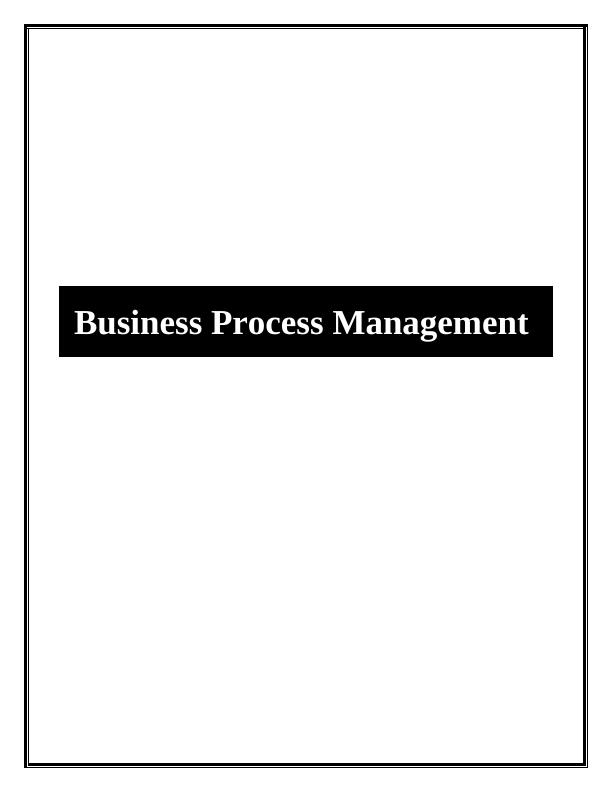
Executive Summary
This report undertakes a critical analysis on the case of IBM, where essential elements are
described related to Business Process Management journey of IBM. This report ensures to
critically evaluate the innovation strategy, processes, infrastructure and organizational structure
of IBM. The intention is to stress on its need for innovation and process changes, business
process design and improvement. The case study assists to identify the evaluation of the
process’s performance, potential change management and risk issues. The research takes effort to
review and examine the details of the organization. Subsequently, to recommend required
suggestions. It is clear that this report covers various areas, which are evaluated based on logical,
rational arguments and theory with a supportive source.
This report undertakes a critical analysis on the case of IBM, where essential elements are
described related to Business Process Management journey of IBM. This report ensures to
critically evaluate the innovation strategy, processes, infrastructure and organizational structure
of IBM. The intention is to stress on its need for innovation and process changes, business
process design and improvement. The case study assists to identify the evaluation of the
process’s performance, potential change management and risk issues. The research takes effort to
review and examine the details of the organization. Subsequently, to recommend required
suggestions. It is clear that this report covers various areas, which are evaluated based on logical,
rational arguments and theory with a supportive source.
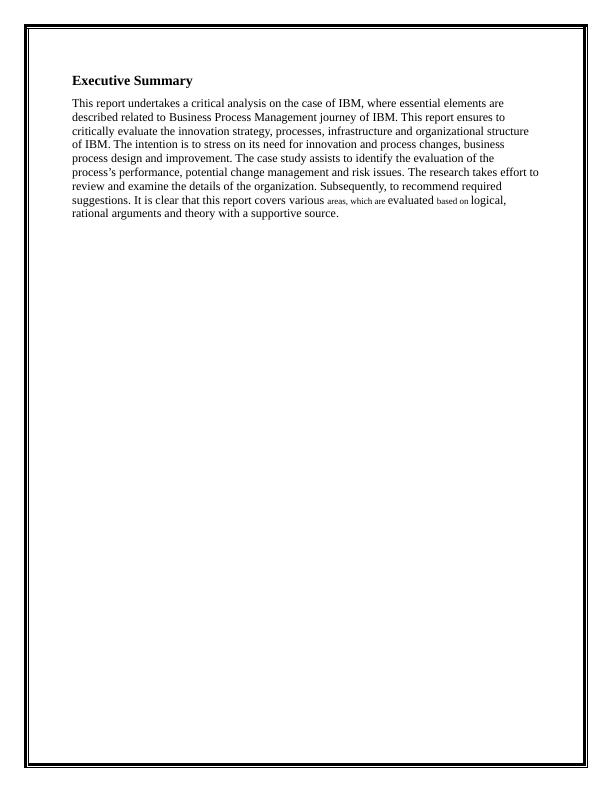
Table of Contents
1. Introduction............................................................................................................................................................ 1
1.1 Company Background........................................................................................................................................ 1
2. Part 1: The Organization’s Need for Innovation and Process Changes.....................................................................2
2.1 Innovation.......................................................................................................................................................... 3
2.2 Innovation Framework....................................................................................................................................... 3
2.3 Innovation Culture.............................................................................................................................................. 5
2.4 Organizational Structure and Design.................................................................................................................. 6
2.5 Funding Model.................................................................................................................................................... 6
2.6 Business Transformation and Integration............................................................................................................8
3. Part 2: Business Process Design and Improvement...................................................................................................8
3.1 Innovation Strategy............................................................................................................................................. 8
3.2 Leadership Team and Key Stakeholders..............................................................................................................9
3.3 Key Business Processes of Innovation..................................................................................................................9
3.4 Role of Research in Innovation..........................................................................................................................10
4. Part 3: Process Performance Evaluation................................................................................................................10
4.1 Process Performance Management and Balanced Scorecard Method.................................................................10
4.2 Process Measurement and Product Development Cycle Time.............................................................................11
5. Part 4: Potential Change Management and Risk Issues..........................................................................................11
5.1 Dealing with Failure.......................................................................................................................................... 11
5.2 Barriers and Enablers of Innovation................................................................................................................. 12
5.3 Critical Success Factors..................................................................................................................................... 13
5.4 Lessons Learnt and Path for Future..................................................................................................................13
6. Conclusion............................................................................................................................................................. 13
References...................................................................................................................................................................... 16
1. Introduction............................................................................................................................................................ 1
1.1 Company Background........................................................................................................................................ 1
2. Part 1: The Organization’s Need for Innovation and Process Changes.....................................................................2
2.1 Innovation.......................................................................................................................................................... 3
2.2 Innovation Framework....................................................................................................................................... 3
2.3 Innovation Culture.............................................................................................................................................. 5
2.4 Organizational Structure and Design.................................................................................................................. 6
2.5 Funding Model.................................................................................................................................................... 6
2.6 Business Transformation and Integration............................................................................................................8
3. Part 2: Business Process Design and Improvement...................................................................................................8
3.1 Innovation Strategy............................................................................................................................................. 8
3.2 Leadership Team and Key Stakeholders..............................................................................................................9
3.3 Key Business Processes of Innovation..................................................................................................................9
3.4 Role of Research in Innovation..........................................................................................................................10
4. Part 3: Process Performance Evaluation................................................................................................................10
4.1 Process Performance Management and Balanced Scorecard Method.................................................................10
4.2 Process Measurement and Product Development Cycle Time.............................................................................11
5. Part 4: Potential Change Management and Risk Issues..........................................................................................11
5.1 Dealing with Failure.......................................................................................................................................... 11
5.2 Barriers and Enablers of Innovation................................................................................................................. 12
5.3 Critical Success Factors..................................................................................................................................... 13
5.4 Lessons Learnt and Path for Future..................................................................................................................13
6. Conclusion............................................................................................................................................................. 13
References...................................................................................................................................................................... 16

1. Introduction
Business process design modelling helps to assure that the mangers and the executive get
facilitated to execute and maintain the consistency of the processes, along with a watchful eye on
the organization's strategy. However, it has significant impact on improving the process
communication, then increases the consistency, control, efficiency pf the operations are
improved and the organization can achieve competitive advantage (Creately Blog, 2017).
The case study of IBM denotes the collaboration within the enterprise, as it tries to
reinvent itself as technology, its possible applications, and clients’ needs. Due to the vastness of
IBM, it is complex to describe the complexity in the organization. The purpose of the research is
critical evaluation of the IBM. This research ensures to determine success evaluation, track
innovation, manage investment for innovation and the research will present the lessons learnt
from critical success factors for a sustainable and encouraging innovation. Additionally, the
barriers for innovation and helpful suggestions will be presented. The importance of learning,
culture and employee work environment along with its impact on innovation will be argued.
The objective of this research is related to the critical analysis on the renowned
organization, IBM, where its major issues will be considered for critical evaluation. The business
process design, business process improvement, process performance evaluation, Potential
Change Management and Risks will be evaluated for IBM. In depth analysis on the details of the
organization will be investigated. The implementation of its relevant concepts and life time
experiences will be argued. Various other areas will be evaluated based on logical, rational
arguments and theory with supportive material.
1.1 Company Background
The Company named International Business Machines Corporation is also known as
IBM. It has a great history of 90 years, which is dedicated to innovation. It is an organization
which carries out inventions, developments, and manufacturing information technologies,
software, storage systems, microelectronics and computer systems. Armonk, New York is its
headquarters. Just 60 years back, basic research programs was started by IBM.
Additionally, even professional solutions consulting and services are offered by the
company throughout the world. IBM. The revenue of IBM is marked as $96.3 billion with $8.4
billion net income, in the year 2004. The total number of employees in the year 2005 (June) is
1
Business process design modelling helps to assure that the mangers and the executive get
facilitated to execute and maintain the consistency of the processes, along with a watchful eye on
the organization's strategy. However, it has significant impact on improving the process
communication, then increases the consistency, control, efficiency pf the operations are
improved and the organization can achieve competitive advantage (Creately Blog, 2017).
The case study of IBM denotes the collaboration within the enterprise, as it tries to
reinvent itself as technology, its possible applications, and clients’ needs. Due to the vastness of
IBM, it is complex to describe the complexity in the organization. The purpose of the research is
critical evaluation of the IBM. This research ensures to determine success evaluation, track
innovation, manage investment for innovation and the research will present the lessons learnt
from critical success factors for a sustainable and encouraging innovation. Additionally, the
barriers for innovation and helpful suggestions will be presented. The importance of learning,
culture and employee work environment along with its impact on innovation will be argued.
The objective of this research is related to the critical analysis on the renowned
organization, IBM, where its major issues will be considered for critical evaluation. The business
process design, business process improvement, process performance evaluation, Potential
Change Management and Risks will be evaluated for IBM. In depth analysis on the details of the
organization will be investigated. The implementation of its relevant concepts and life time
experiences will be argued. Various other areas will be evaluated based on logical, rational
arguments and theory with supportive material.
1.1 Company Background
The Company named International Business Machines Corporation is also known as
IBM. It has a great history of 90 years, which is dedicated to innovation. It is an organization
which carries out inventions, developments, and manufacturing information technologies,
software, storage systems, microelectronics and computer systems. Armonk, New York is its
headquarters. Just 60 years back, basic research programs was started by IBM.
Additionally, even professional solutions consulting and services are offered by the
company throughout the world. IBM. The revenue of IBM is marked as $96.3 billion with $8.4
billion net income, in the year 2004. The total number of employees in the year 2005 (June) is
1
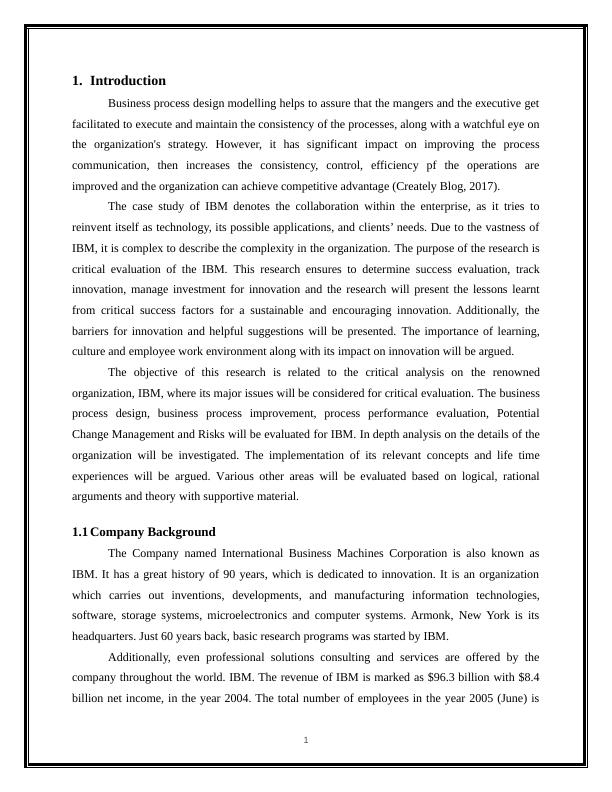
observed to be nearly 319,000 and the number of stakeholders is 671,610. It effectively invests
on research and development (R&D) i.e., nearly 6% of its revenue which is $5.7 billion. IBM
also funds around 12% for the central research organization, which comprises of 8 research
laboratories. For research it contain greater than three thousand engineers and scientists.
Globally, it operates on 24 development laboratories. The main aim of IBM Research is to
interact with each part of IBM like, its divisions, companies, owned subsidiaries, partnerships,
joint ventures etc., for fulfilling the vision and mission of the business.
Failure at IBM is approached with an Innovation Failure Philosophy, where how it is
implemented for innovation depends on the unit of the organization that is involved. It is
observed in the case study that some of the objectives are not meeting in IBM’s integrated supply
chain, despite of IBM’s consistent approach to identify, highlight, and drive correct action for all
its business scenarios. Myriad approaches are used for corrective actions. In IBM, its supply
chain executives hardly characterize situations to “acceptable failures,” instead some particular
objectives and metrics are occasionally and intentionally sacrificed, to benefit IBM’s broad goal.
The barriers identified in IBM refers to frequent challenges in time management, which
also creates obstacles for innovation in the department of supply chain. Because, daily
operational job requirements are so great that the employees and teams feel that generation of
longer-term innovation and work on innovation projects should be sacrificed. Failure is accepted
on a proportion of risky scientific projects, however failure rate metric is not stated by IBM. The
innovation activities which see failure might either be early for the already known markets or it
might hardly fit with the established channels. Therefore, work on constant improvement of
methods is in progress by IBM, for driving innovation into the marketplace.
2. Part 1: The Organization’s Need for Innovation and Process Changes
With the constantly changing world, change and innovation have a significant role for all
the organizations. If adapting to the change is not possible for an organization, the organization
cannot stay competitive any more. For enforcing a successful change in the organizational
processes, people have a significant role. The main purpose of change is to maximize the profit
of the organization, with certain changes in the structure, strategy, innovation and organizational
culture.
The below section assesses the IBM organization’s ***with a critical and practical
2
on research and development (R&D) i.e., nearly 6% of its revenue which is $5.7 billion. IBM
also funds around 12% for the central research organization, which comprises of 8 research
laboratories. For research it contain greater than three thousand engineers and scientists.
Globally, it operates on 24 development laboratories. The main aim of IBM Research is to
interact with each part of IBM like, its divisions, companies, owned subsidiaries, partnerships,
joint ventures etc., for fulfilling the vision and mission of the business.
Failure at IBM is approached with an Innovation Failure Philosophy, where how it is
implemented for innovation depends on the unit of the organization that is involved. It is
observed in the case study that some of the objectives are not meeting in IBM’s integrated supply
chain, despite of IBM’s consistent approach to identify, highlight, and drive correct action for all
its business scenarios. Myriad approaches are used for corrective actions. In IBM, its supply
chain executives hardly characterize situations to “acceptable failures,” instead some particular
objectives and metrics are occasionally and intentionally sacrificed, to benefit IBM’s broad goal.
The barriers identified in IBM refers to frequent challenges in time management, which
also creates obstacles for innovation in the department of supply chain. Because, daily
operational job requirements are so great that the employees and teams feel that generation of
longer-term innovation and work on innovation projects should be sacrificed. Failure is accepted
on a proportion of risky scientific projects, however failure rate metric is not stated by IBM. The
innovation activities which see failure might either be early for the already known markets or it
might hardly fit with the established channels. Therefore, work on constant improvement of
methods is in progress by IBM, for driving innovation into the marketplace.
2. Part 1: The Organization’s Need for Innovation and Process Changes
With the constantly changing world, change and innovation have a significant role for all
the organizations. If adapting to the change is not possible for an organization, the organization
cannot stay competitive any more. For enforcing a successful change in the organizational
processes, people have a significant role. The main purpose of change is to maximize the profit
of the organization, with certain changes in the structure, strategy, innovation and organizational
culture.
The below section assesses the IBM organization’s ***with a critical and practical
2
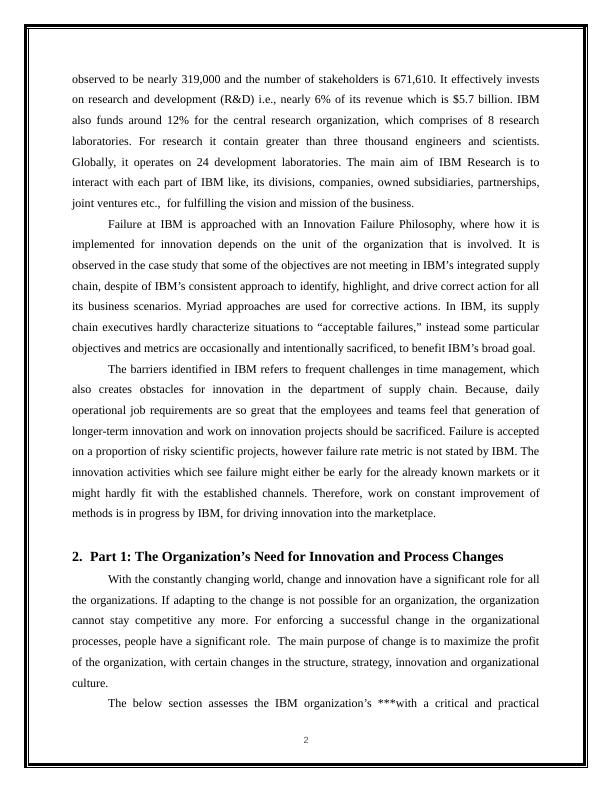
approach, with proof.
2.1 Innovation
Innovation is different from creativity (Tohidi and Jabbari, 2012). According to the belief
of IBM and their higher official Nick Donofrio, in every business unit innovation is a main
ingredient for strategic focus. Where, instead of allotting a separate unit for innovation
responsibility, it is integrated in all the things that the company does.
As IBM relies on each employee to have innovation accountability, this has become a
personal commitment of the employees. At IBM, innovation is being enhanced by shifting its
resources and decisions more close to the workforce and clients, as they interaction with each
other. Inspiration on innovation is expected from each IBMer by collaborating with each other
using multiple channels. However, only this type of accountability is not sufficient to get best
results from the employees, it is reviewed and examined that work environment plays a
significant role here for enhancing the work of the employees (Fajans, 2014).
2.2 Innovation Framework
Innovation is not new for IBM as it has been practicing it since 90 years, where it denotes
innovation as a business model, which organizes the principle. The IBMers mandate in driving
innovation for every single thing.
According to (Stilgoe, Owen and Macnaghten, 2013), there exists challenges for the
democratic governance of the emerged innovation, and a framework is provided for a responsible
innovation which addresses the concerns related to social and ethics.
Constant scanning of environment, then gathering trend related information, future
realities of the project and work efforts are also beneficial for a successful innovation
organization, which is actually done by IBM effectively. This efforts of IBM are to determine its
future needs.
The framework is important because it contains the power to underpin the practical as
well as a systematic approach for managing the processes (Stilgoe, Owen and Macnaghten,
2013).
It is exact need that IBM designed its innovation framework for, where the interlinked
dimensions for innovation includes, product/offerings, process, and business model innovation.
For innovation sustaining enablers support to create an environment where the innovation
3
2.1 Innovation
Innovation is different from creativity (Tohidi and Jabbari, 2012). According to the belief
of IBM and their higher official Nick Donofrio, in every business unit innovation is a main
ingredient for strategic focus. Where, instead of allotting a separate unit for innovation
responsibility, it is integrated in all the things that the company does.
As IBM relies on each employee to have innovation accountability, this has become a
personal commitment of the employees. At IBM, innovation is being enhanced by shifting its
resources and decisions more close to the workforce and clients, as they interaction with each
other. Inspiration on innovation is expected from each IBMer by collaborating with each other
using multiple channels. However, only this type of accountability is not sufficient to get best
results from the employees, it is reviewed and examined that work environment plays a
significant role here for enhancing the work of the employees (Fajans, 2014).
2.2 Innovation Framework
Innovation is not new for IBM as it has been practicing it since 90 years, where it denotes
innovation as a business model, which organizes the principle. The IBMers mandate in driving
innovation for every single thing.
According to (Stilgoe, Owen and Macnaghten, 2013), there exists challenges for the
democratic governance of the emerged innovation, and a framework is provided for a responsible
innovation which addresses the concerns related to social and ethics.
Constant scanning of environment, then gathering trend related information, future
realities of the project and work efforts are also beneficial for a successful innovation
organization, which is actually done by IBM effectively. This efforts of IBM are to determine its
future needs.
The framework is important because it contains the power to underpin the practical as
well as a systematic approach for managing the processes (Stilgoe, Owen and Macnaghten,
2013).
It is exact need that IBM designed its innovation framework for, where the interlinked
dimensions for innovation includes, product/offerings, process, and business model innovation.
For innovation sustaining enablers support to create an environment where the innovation
3
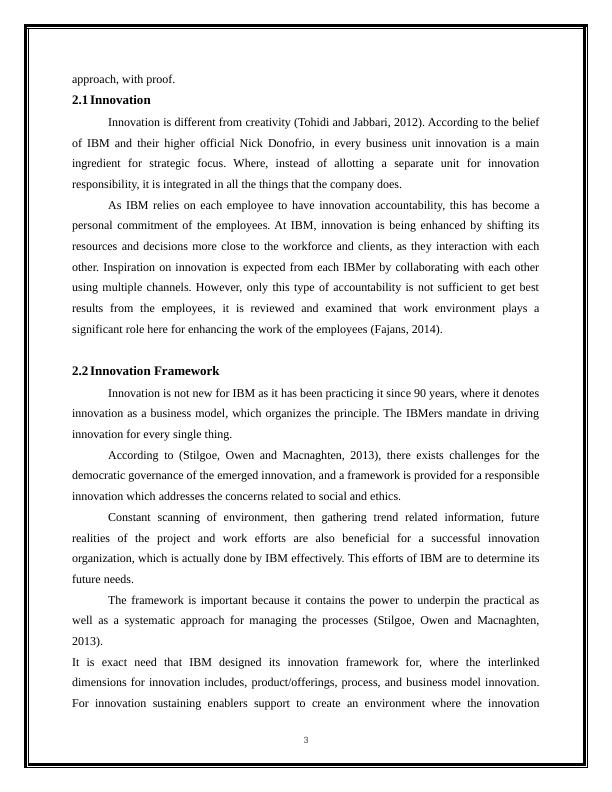
End of preview
Want to access all the pages? Upload your documents or become a member.
Related Documents
IBM’s Innovation Strategy: Analysis of the Most Innovative Companylg...
|23
|6177
|162
IBM's Innovation Strategy and Business Process Managementlg...
|13
|3949
|111
COIT20252 Business Process Managementlg...
|21
|7267
|149
Strategic Use of IS/IT in Innovationlg...
|15
|3914
|50
(Doc) Business Process Management Assignment Samplelg...
|15
|415
|31
The Queensland Health Payroll Project Report 2022lg...
|15
|2821
|46
